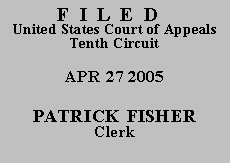 UNITED STATES COURT OF APPEALS
UNITED STATES COURT OF APPEALS
 UNITED STATES COURT OF APPEALS
UNITED STATES COURT OF APPEALS
| GEORGE BROWN,
Petitioner-Appellant, v. LAWRENCE TAFOYA, Warden; ATTORNEY GENERAL FOR THE STATE OF NEW MEXICO, Respondents-Appellees. |
|
Because the magistrate judge's order presents a thorough and detailed recitation of the facts, we will only set forth a brief background of the case. Brown was convicted by a jury of possession of cocaine; trafficking a controlled substance (cocaine) by possession with intent to distribute (two counts); and possession of drug paraphernalia. After sentencing, Brown filed his first appeal with the New Mexico Court of Appeals. On April 26, 2000, the court of appeals ruled that Brown's two convictions for trafficking should merge into one conviction, but that his remaining claims lacked merit. The court remanded the matter for modification of Brown's judgment and sentence. Through counsel, Brown petitioned for a writ of certiorari in the New Mexico Supreme Court. The petition was denied on June 14.
On April 2, 2001, Brown, proceeding pro se, filed a petition for writ of certiorari or in the alternative a common-law petition for a writ of habeas corpus with the New Mexico Supreme Court. On June 29, the New Mexico Supreme Court, under the mistaken impression that the trial court had re-sentenced Brown, construed the petition as a direct appeal and transferred the petition to the court of appeals. On October 24, the court of appeals dismissed and remanded Brown's appeal. On January 24, 2002, the trial court re-sentenced Brown to the same sentence originally entered.
Brown then filed his third appeal in which he argued: that the delay in his re-sentencing violated his right to a speedy trial and should result in a dismissal of the charges; that double jeopardy required the dismissal of his convictions under the holding of State v. Nunez, 2 P.3d 264 (N.M. 1999); and that his sentence enhancements under the New Mexico Habitual Offender Act and the New Mexico Controlled Substances Act were unlawful.(1) The court of appeals concluded that there had been a twelve-month delay in Brown's sentencing that was not attributable to his actions. After balancing the four factors for determining a Sixth Amendment violation as enumerated in Barker v. Wingo, 407 U.S. 514, 530 (1972), the court determined that Brown did not suffer demonstrable or substantial prejudice from the delay in re-sentencing and that therefore his Sixth Amendment rights were not violated. On Brown's second issue, the court held that the record was insufficient to determine the merits of his double-jeopardy claim. On the third issue, the court declined to review the merits of the claim because Brown could have raised it in his first appeal.
Brown petitioned unsuccessfully for a writ of certiorari to the New Mexico Supreme Court. Brown then filed his federal habeas petition with the district court in which he raised the same issues as before the New Mexico Court of Appeals. The district court concluded that the state court's decision that Brown's Sixth Amendment rights were not violated by the delay in his re-sentencing was not contrary to clearly established law, nor was it an unreasonable determination of the facts in light of the evidence presented. The district court determined that the other two issues, as presented by Brown, alleged violations of New Mexico law and did not state a claim for federal habeas relief.
In order to be entitled to habeas relief on his Sixth Amendment claim, Brown must demonstrate that the state court's decision was "contrary to, or involved an unreasonable application of, clearly established Federal law, as determined by the Supreme Court of the United States," or was "based on an unreasonable determination of the facts in light of the evidence presented in the State court proceeding." 28 U.S.C. § 2254(d)(1) & (2). Further, state court findings are presumed to be correct unless the petitioner rebuts this presumption by clear and convincing evidence. 28 U.S.C. § 2254(e)(1). With respect to Brown's other two claims, because the state court did not address the merits of these claims, we review de novo the district court's legal conclusion that Brown was not eligible for federal habeas relief on these claims because they were based solely on violations of New Mexico law, see Paxton v. Ward, 199 F.3d 1197, 1204 (10th Cir. 1999), and conclude that the conclusion was warranted.
Our review of the appellate briefs, the record, and the applicable law, lead us to conclude that, for substantially the reasons stated in the magistrate judge's proposed findings and recommended disposition (as adopted by the district court in its June 30, 2004 order and judgment), Brown has not established his entitlement to habeas relief. The judgment of the district court is AFFIRMED.
Entered for the Court
Circuit Judge
*. This order and judgment is not binding precedent, except under the doctrines of law of the case, res judicata, and collateral estoppel. The court generally disfavors the citation of orders and judgments; nevertheless, an order and judgment may be cited under the terms and conditions of 10th Cir. R. 36.3. After examining the briefs and the appellate record, this panel has determined unanimously that oral argument would not materially assist the determination of this appeal. See Fed. R. App. P. 34(a)(2); 10th Cir. R. 34.1(G). The case is therefore ordered submitted without oral argument.
1. Brown raised three other issues before the court of appeals and in his federal habeas petition, but he did not raise those issues before this court. Accordingly, those issues are waived and we will not address them here. See State Farm Fire & Cas. Co. v. Mhoon, 31 F.3d 979, 984 n.7 (10th Cir. 1994).